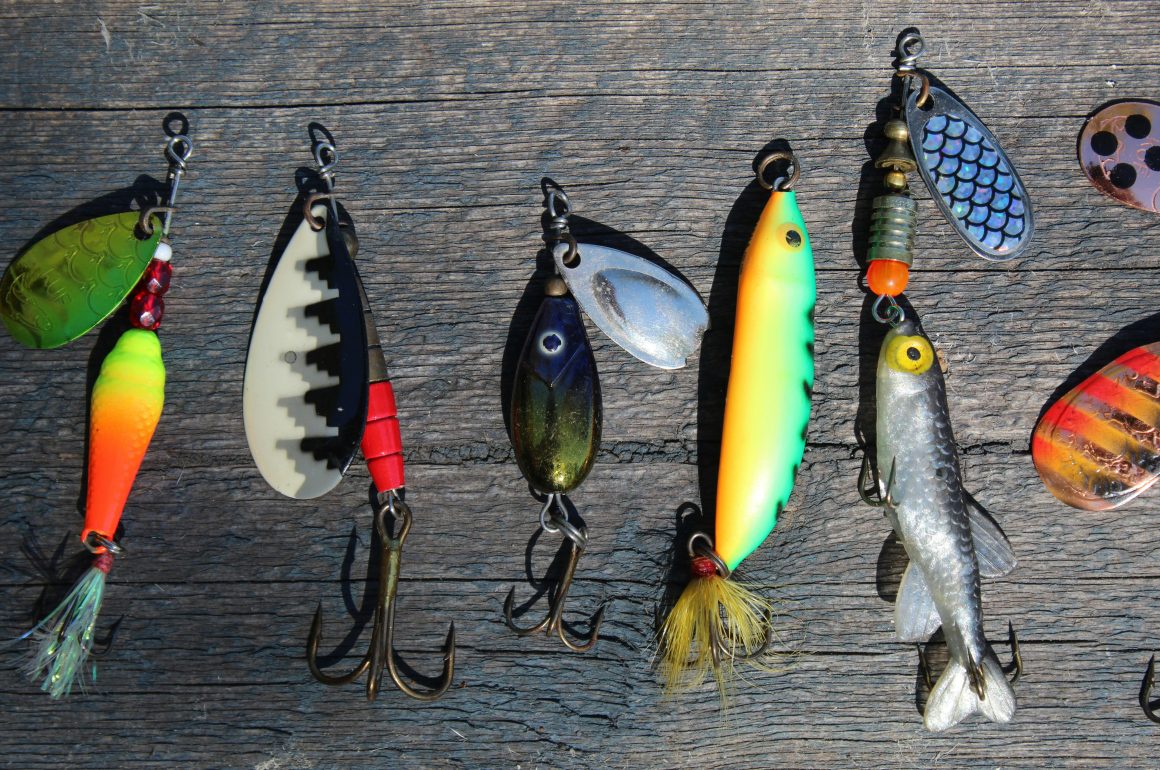
About this same time last November I was birding at a nearby marina to look for two reported Little Gulls. I saw plenty of Bonaparte’s Gulls, Herring Gulls and, of course, Ring-billed Gulls. But no Little Gulls. As we know, the best way to find them is while they are in flight. So who knew which dock piling they were resting on? I was ready to call it quits but decided to take one last walk down one of the docks. There was no Little Gull, but I did find the Herring Gull below.
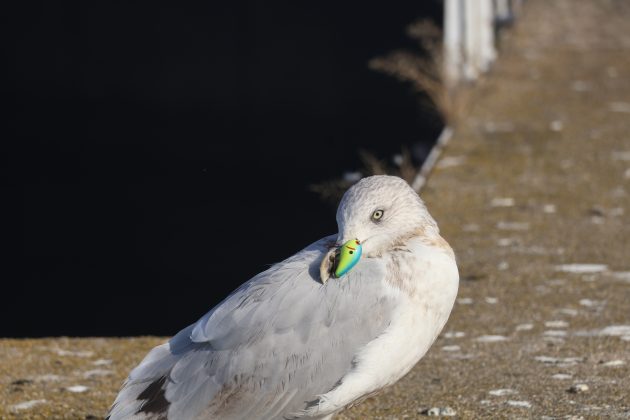
This gull had not been present the first time I walked this dock. In the photo you can clearly see the problem. A fishing lure is securely hooked to its nostril. Where this kind of lure is used to attract a fish to strike from below, the gull seemingly struck from above. As I inched forward for photos, the bird inched backwards. It seemed unwilling to take flight and I was unwilling to encroach further.
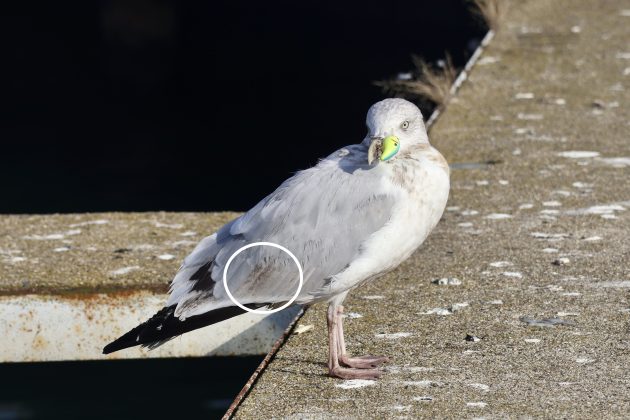
The circled area in the photo above is meant to show a stain of red which I thought likely to be blood where the gull had rubbed its feathers in an effort to dislodge the lure. This is just a guess. I left the marina without seeing the Little Gull and bothered by the predicament of this Herring Gull.
The following April 27th, I was birding along the Iron Belle Nature Trail on Belle Isle (of Urban Birding fame) trying to achieve the eBird April challenge of making twenty visits to the same location during the month (I didn’t make it). An asphalt path runs along a canal on which a Mute Swan was paddling along. Having many Mute Swan photos I decided I didn’t need another and only gave it a glance. I tried for photos of a Belted Kingfisher, but they are so camera shy I was unsuccessful. I came up to two young fishermen, brothers, fishing along the canal. They were fishing for small-mouth bass which hide in the tree roots at the edge of the canal. One of the boys said, “Hey, did you see that the swan had a fishing lure stuck in its bill? Someone must have hooked it and then cut the line.” I hadn’t seen the fishing lure and I rushed back to catch up with the swan.


I thought the poor thing appeared miserable and, again, I thought it can’t last long. By the end of April Mute Swans are paired up and matting and this one was alone and with a fishing lure stuck to its bill. I walked back toward the boys and one asked if I got a photo of the swan. I said yes and asked if they had caught anything. “No, not yet,” was his reply. I was about twenty feet further up the trail when one of the boys yelled out, “Hey, I got one.” I turned back to see.

I asked if he was going to keep it. “Nah, we throw them back. We’re just fishing for fun.” I thought my kind of fishermen. The fish was about ten inches long and I’m sure it gave a little fight.
I finished out the month of April with a couple more visits to Belle Isle. I knew I would not meet the eBird challenge, but now I was looking for the Mute Swan. I saw it again the next day on one of the island’s lakes but after that did not see it again.
That is, until May 9th.
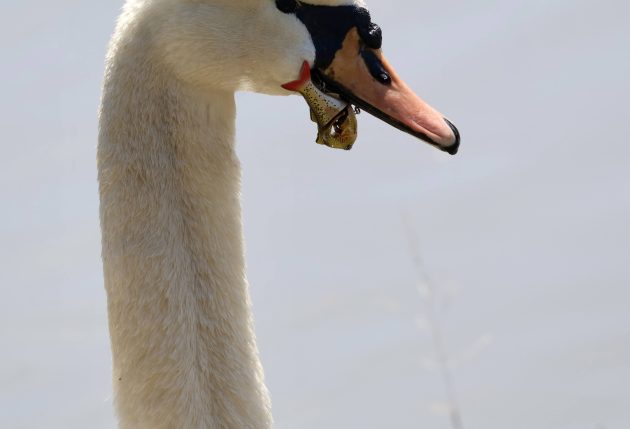
This time I was birding on the opposite end of the canal where I had originally seen the swan and there it was, fishing lure still attached. It was still alone, was preening vigorously and acting like a normal Mute Swan. Thinking that it surely would die I was surprised that, two weeks later, it was alive and even appeared to be well. That was a good lesson to learn. I left it to meet up with a friend and told her the story. An hour or so later we returned together so she could see the swan. The bird was sleeping along the edge of the canal and we opted not to disturb it. But this is not the end of the story.

On May 11th I returned to Belle Isle for a final visit before departing on a birding trip to Finland and Norway. Here again was the Mute Swan, still alone, same canal, same location but, this time, sans fishing lure. So how do I know this was the same swan? When I got home I matched up all of my photos and put them in context with the situation. It is the same bird. Where did the fishing lure go? Did the bird dislodge it while feeding below water? Possibly, but I think the more likely answer is that the park’s Department of Natural Resources (DNR) staff were also aware of this bird and, while it was on the narrow canal, saw an opportunity to net it and remove the lure.
So, all of the above just to write about what a fisherman should do when a bird is hooked. I Googled for the answer and readers can do the same. The story above illustrates that this is probably a bigger problem than most of us are aware. I recalled the boys fishing along the canal and one of them saying, “Someone must have hooked it and then cut the line.” They knew that cutting the line was not what a fisherman should do. So, then what to do?
Hint: Do not cut the line!
First: Take preventative measures. 1. Be aware of birds flying by when casting your line. 2. Never leave baited fishing hooks and poles unattended. 3. Carry wire cutters or scissors in your tackle box.
Second: The more detailed explanation is too much to write here. But please do look this up. Easy to do just by Googling the question “What do I do if I hook a bird with a fishing hook?”
A summary is not too detailed. For a shallow hook: 1. Reel in slowly, carefully and calmly. 2. Get a helper. 3. Protect yourself; wear sunglasses or other glasses to protect your eyes, use gloves if you have them. 4. Calm the bird by covering its head with a towel or other light cloth. 5. Remove the hook by cutting the barb and gently back the hook out. 6. Release the bird by placing it on the ground or dock and facing the water.
For a hook that is deeply embedded: 1. Do not remove the hook yourself. 2. Do not cut the line. 3. Contact a professional.
Following my experience with the situations of the above two birds, I went on an online research expedition. In addition to many You Tube videos, I also found the following.
- Angler perceptions of pelican entanglement reveal opportunities for seabird conservation on fishing piers in Tampa Bay, by B. Alexander Simmons.
- From Tampa Bay Audubon: Save Hooked Birds – Don’t Cut the Line! (This site includes graphic photos.)
There are many other online sources. From watching and reading, I also observed that it would be relatively easy for a skilled casting fisherman to intentionally hook a bird, especially waterfowl. This awareness gave me a queasy feeling. To those who might say, and I have heard say in other contexts, oh well, there are plenty of Herring Gulls and the other is just a non-native Mute Swan. This is hardly the point. It could also be an owl, a kingfisher, a Little Gull, a diving duck, a cormorant, heron or egret, or any number of other birds.
I have often compared birding and fishing as somewhat similar-style hobbies, or if you prefer, passions with a deep commitment from both sides. They are relatively quiet pursuits done alone or with friends. Many birders also fish and vice-versa. Certainly fishermen know their birds. On the coasts, fishing boats often offer pelagic trips as a side hustle.
Birds have hard lives and need all the help we can offer them. Anything we can do, small or large, to make their lives easier is worth all of our efforts.
Cover photo: by Anne Nygård, free download from unsplash.com




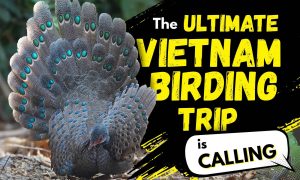

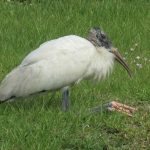

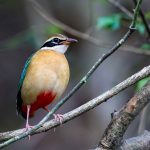
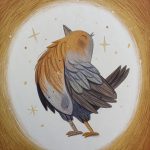

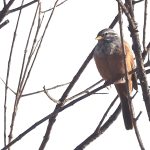
Leave a Comment